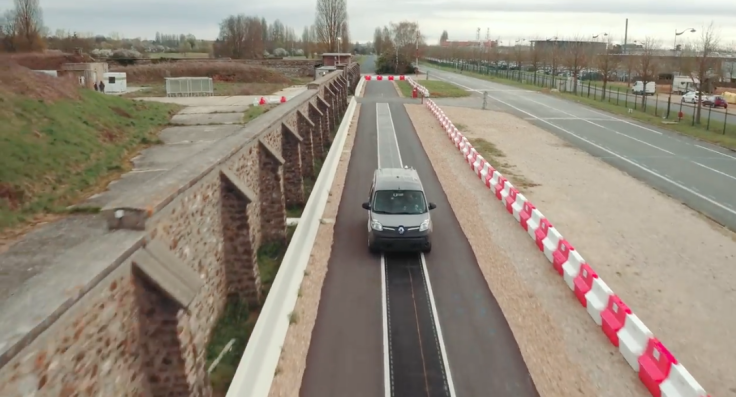Qualcomm Shows How To Wirelessly Charge Electric Vehicles While Driving

Qualcomm showed the world how an electric car can be charged wirelessly while on the road Thursday.
“Imagine a future where you’re in your EV on a highway and able to pick up [a] charge while driving,” Qualcomm teased in a blog post.
Read: iPhone 8 Release Might Be Delayed Until October Or November. Wireless Charging, OLED Screen Blamed
Qualcomm revealed the technology called dynamic electric vehicle charging (DEVC), which lets cars charge while driving. DEVC, which was designed and built based on the Qualcomm Halo wireless electric vehicle charging technology, can provide an electric vehicle (EV) a 20-kilowatt charge at highway speeds through tracks embedded with wireless charging hardware.
Two Renault Kangoo vehicles with Qualcomm’s Halo DEVC system were tested on the tracks and charged simultaneously. The track can charge the EVs whether they’re driving forward or in reverse.
The DEVC demos took place at a 100-meter test track in France built by Vedecom, part of the 9 million-euro FABRIC project funded mostly by the European Commission.
FABRIC, which began in 2014, has 25 organizations from nine European countries focused on wireless DEVC. The organizations include automotive manufacturers, suppliers, service providers and research firms. The project’s main goal “is to conduct a feasibility analysis of wireless DEVC as a means of EV range extension.”
“We see dynamic charging as a great vision to further enhance the ease of use of EVs, thus the accessibility of EVs for all,” Groupe Renault Electric Vehicle Program Director Eric Feunteun said in a statement.
Read: iPhone Wireless Charging: Apple Wants You To Charge Your Device Via Wi-Fi In The Future
Qualcomm released a video showing how the wireless charging technology works.
The DEVC system at the FABRIC track is made up of 4-by-25 meter stubs, each running from its own power supply. Each stub “powers 14 Base Array Network blocks coupled magnetically into the backbone cable,” Qualcomm said.
The power is then wirelessly transferred from the track to two 10 kW vehicle pads under the car.
Qualcomm will turn over the Halo DEVC system to Vedecom, which will perform tests for FABRIC on the operation, safety and efficiency of energy transfer to the vehicles in different scenarios.
“The installation of one of the world’s first DEVC test platforms has provided us with a unique test facility and we look forward to expanding our expertise with the future testing,” Vedecom CEO Luc Marbach said in a statement.
Qualcomm made it clear it will not manufacture the equipment and prefers a licensing business model.
Wireless Charging: Apple and Sony
Other companies have looked into wireless charging. A patent filing last month suggested Apple was looking into the possibility of wirelessly charging iPhones via Wi-Fi. Meanwhile, numerous reports have claimed the company will release the iPhone 8 with wireless charging capabilities.
Another patent, filed by Sony in March, shows the company is looking into wirelessly charging devices by sucking power from other gadgets nearby. The patent cites electronic devices, such as tablets and smartphones, and is focused on finding “methods and systems for configuring wireless power and data transmission between one or more consumer electronic devices.”
© Copyright IBTimes 2024. All rights reserved.





















